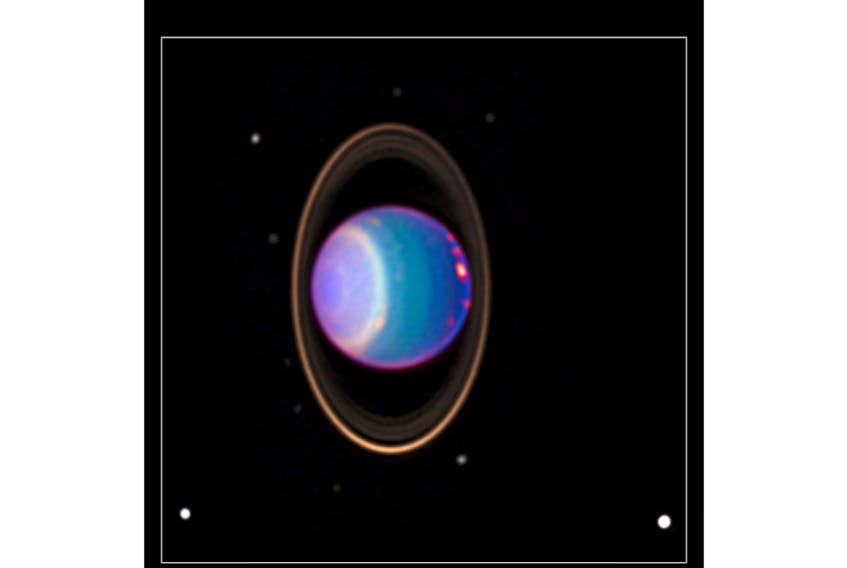In Greek mythology, Uranus (from the Greek, Ouranos) was the Father Sky, both the son of and husband to Gaia (Mother Earth). From their union came numerous other deities, among them the Titans, who, in turn, were ancestors to most of the Greek gods and goddesses.

The seventh planet from the sun, Uranus was discovered purely by accident. Though it was listed as a "star" on the star charts of the Greek astronomer, Hipparchus, as far back as 128 BC (and all subsequent astronomical charts), it wasn't until the late 1700s that it was found to be an actual planet.
While surveying the night sky with his home-made telescope on March 13, 1781, British astronomer William Herschel observed the "star." Additional observations by Herschel found it to have constant motion relative to the background stars, and it was subsequently designated a planet. Herschel named it Georgian Sidus (German for "Georgian star"), after the reigning British monarch, George III; it received its official Greek name Uranus in March 1782.
Uranus orbits at an average distance of 2,870,972,200 kilometres (19.4 AUs) from the sun. It has an orbital period of 84.1 Earth years, and has an equatorial diameter of approximately 51,118 km (roughly four times that of Earth).
Like Jupiter and Saturn, the atmosphere of Uranus is made of primarily of hydrogen (82.5 per cent) and helium (15.2 per cent), with some methane (2.3 per cent) and small amounts of ammonia and water vapor.
Uranus is unique among the solar system planets, in that its axis of rotation is tilted almost in line with its orbital plane around the sun. It is thought that this occurred billion of years ago, when the still-forming planet was struck by a stray, massive planetesimal, which knocked the planet on its side.
Uranus also shares the distinction of being one of only three planets in the solar system (the others being Venus and Pluto) to have a backward or "retrograde" rotation - it rotates opposite to the direction of its orbital motion.
Uranus is thought to have a small icy rock core, a mantle of liquid water with dissolved ammonia, and an outer layer of liquid molecular hydrogen and helium, overlaid by a thin atmosphere shell. Like Jupiter, Uranus also has a system of dark rings composed of ice and rock, with very low reflectivity. It wasn't until 1977, when astronomers were using Uranus's occultation of a distant star to determine the planet's size, that the planet's nine rings were discovered; the Voyager 2 flyby of Uranus in 1986 discovered two more.
Uranus has a total of 27 moons; the moons Titania and Oberon were discovered in 1781, while Umbriel, Ariel and Miranda weren't discovered until 1851; all five were named after spirits in Shakespeare's plays. The 1986 flyby of Uranus by Voyager 2 added another two, and ground-based telescopes found another 12 between 1997-2003.
Uranus shines at mag. +5.7 (just within naked-eye range under a dark sky away from city lights); a good (and current) sky chart will help you locate this bluish-green "star" in the constellation of Aries - the Ram this month.

Mercury transits (passes in front of) the sun Nov. 11, as it reaches inferior conjunction. Do not attempt to view this rare celestial event with your naked eyes, through your binoculars or through a telescope, unless you have the proper eye protection or your binoculars or telescope have the necessary optical shielding; looking directly at the sun (especially through binoculars or a scope) could severely and permanently damage your eyesight. There will be sufficient media coverage of this event on both television and the Internet; follow it there, and save your eyesight. Mercury will be visible in the eastern, pre-dawn sky during the latter part of the month.
Meanwhile, Venus (mag. -3.8) starts her climb out of the glare of the evening dusk. After the sun disappears below the western horizon, you may catch a brief glimpse of Venus below Jupiter low on the southwestern horizon before it sets about an hour after sunset. As it climbs higher in the evening sky throughout the month, Venus will gain prominence.
Venus and Jupiter will be in a close conjunction on Nov. 24. Mars (mag. +1.8) returns to visibility in the southeastern pre-dawn sky, rising about two hours before the sun. Like Venus, as Mars climbs higher in the morning twilight sky, it will become more prominent and easier to find before being lost in the light of the rising sun.
Jupiter (mg. -1.7) is visible in the southwest sky at dusk, but sets between 7-8 p.m. Saturn (mag. +0.9) sits about two hands width (at arm's length) to the left of and above Jupiter; it sets around 9 p.m.
The Leonid (radiant in the constellation of Leo - the Lion) meteor shower peaks on the evening/pre-dawn of Nov. 17-18, with the best time to see the most meteors being the pre-dawn hours of Nov. 18. The Leonids are debris from Comet Temple-Tuttle (which has a 33.3 year orbital period), and have been known historically to produce numerous "meteor storms", when more than 1,000 meteors/hour have fallen. In 1833, over 100,000/hour fell, and in 1966, between 2,400-3,000/minute fell. Unfortunately, this year's Leonids will only produce about 10-15/hour (under a dark sky away from city lights), with the waning, gibbous moon obscuring many of the fainter meteors; still, there is always a chance of many more.
Until next time, clear skies.
Glenn K. Roberts lives in Stratford, P.E.I., and has been an avid amateur astronomer since he was a small child. He welcomes comments from readers, and anyone who would like to do so is encouraged to email him at [email protected].
Next week: Neptune - Mighty Monarch of the Ocean.
Events:
Nov. 11 - Mercury at inferior conjunction; transits the Sun
12 - Full Moon
17/18 - Leonid meteor shower peaks









